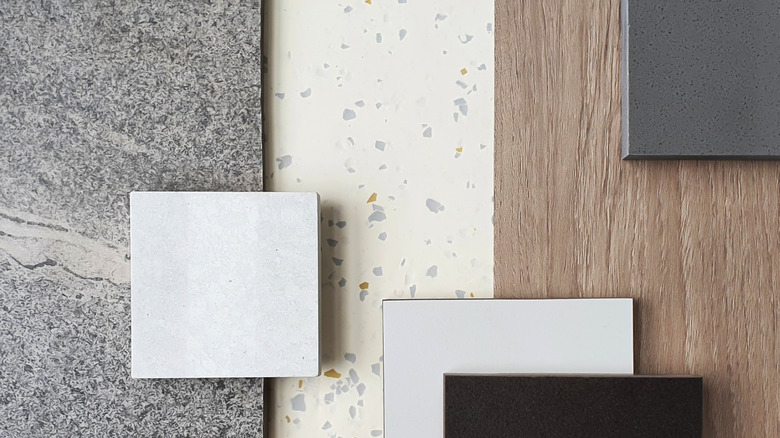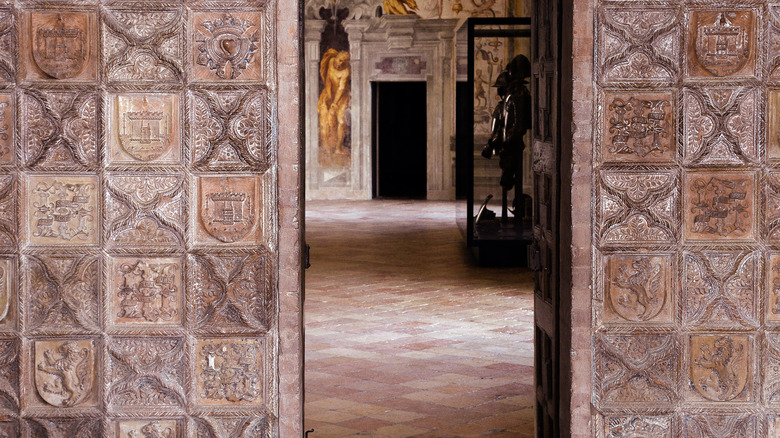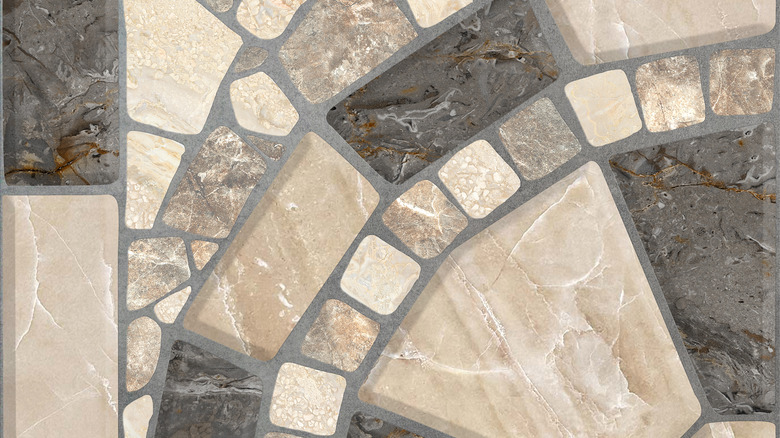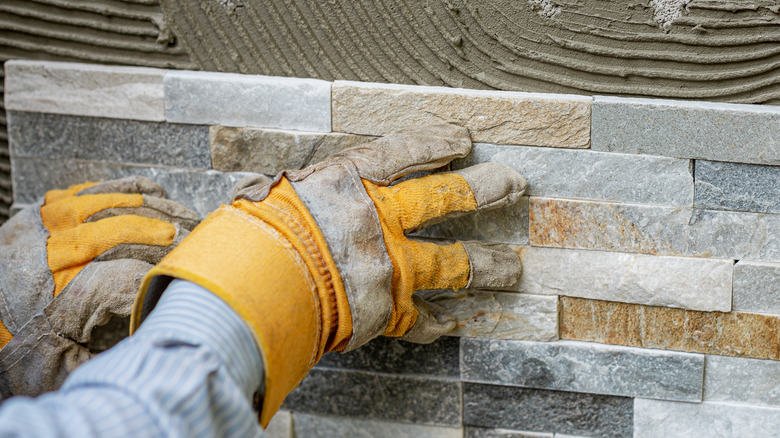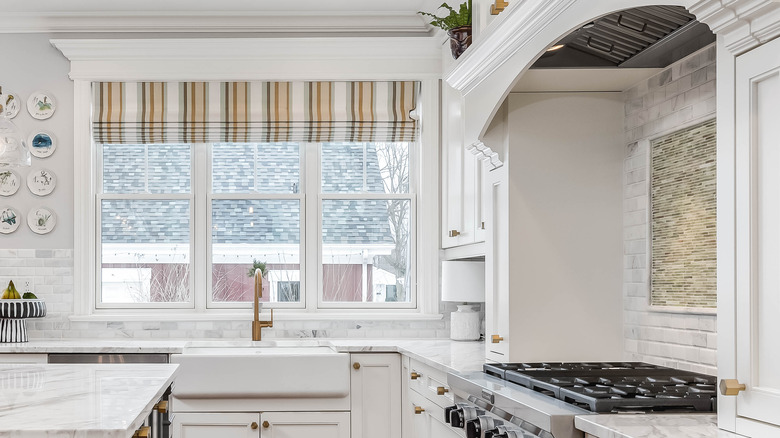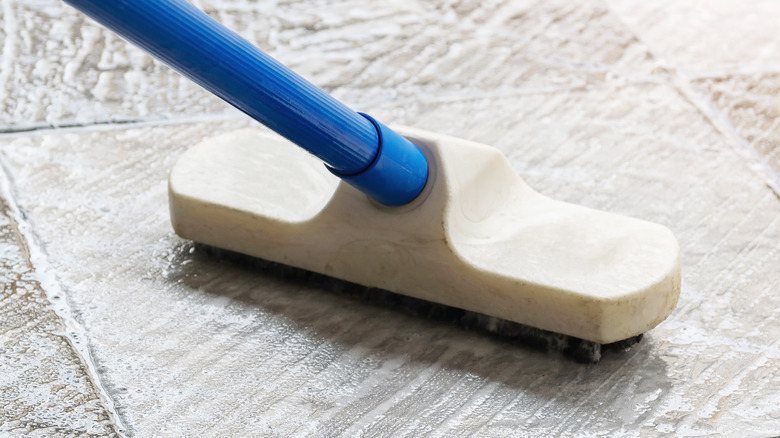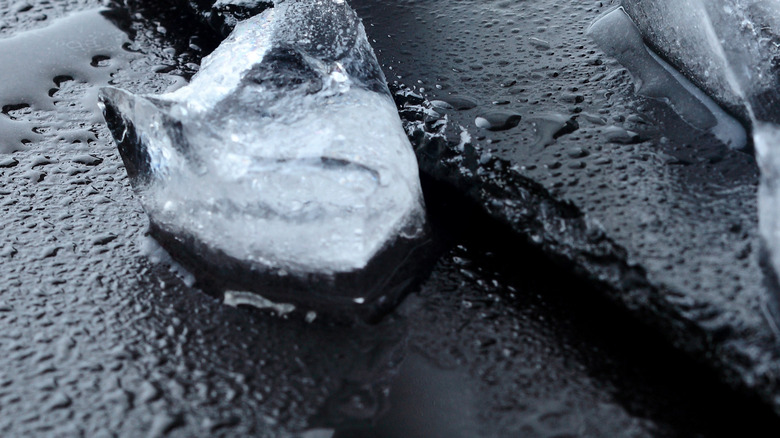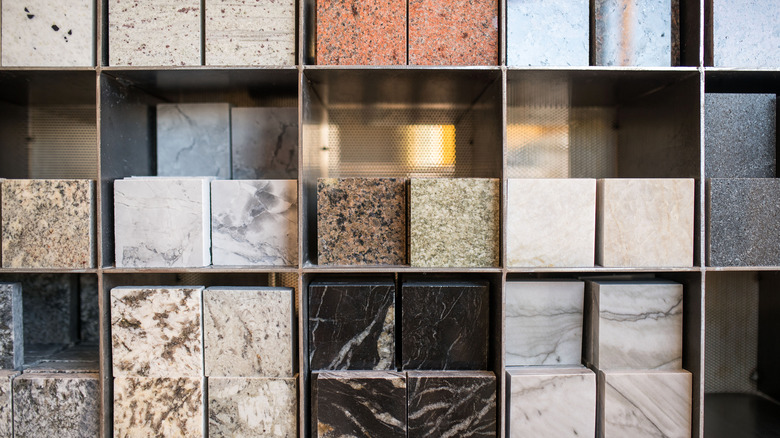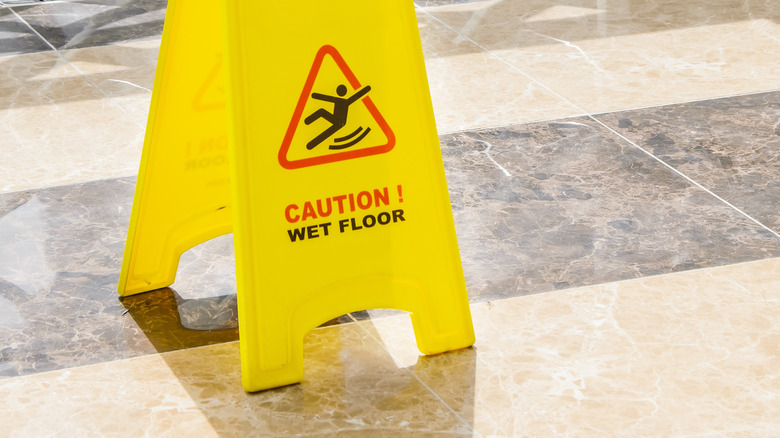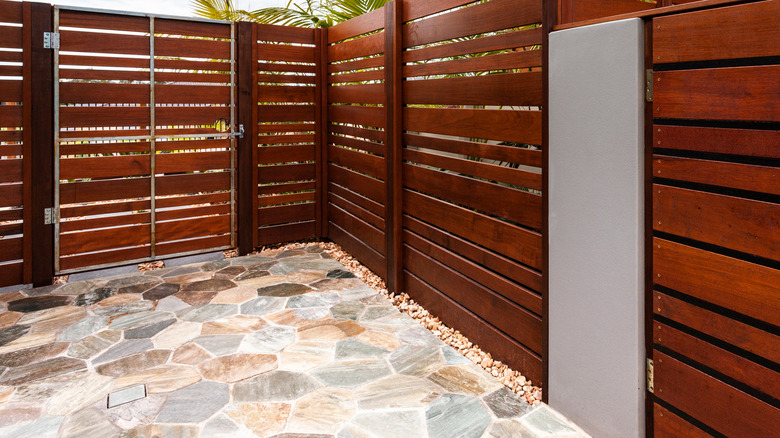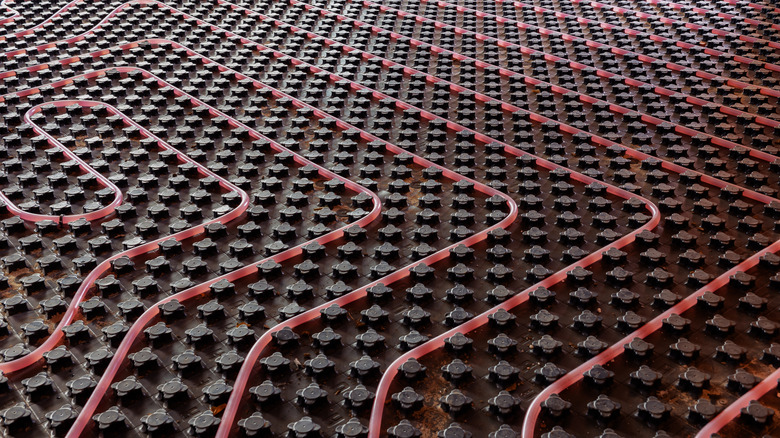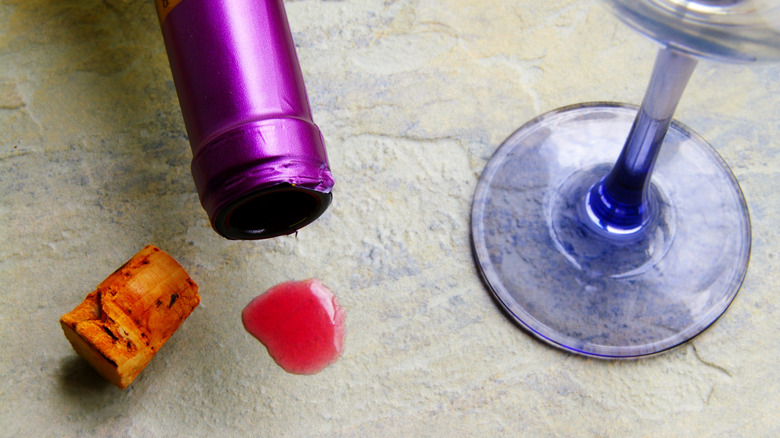What You Need To Know About Natural Stone Tile Before You Buy
Natural stone tile can be used in any room to bring a natural element to your home's interior. With many types to choose from, stone tile is a great choice for anything from a kitchen backsplash to a shower floor. Many people instantly think of granite or marble when they consider natural stone tiles, but slate, limestone, and travertine are also popular options. Depending on your purpose, stone tile can be finished to a high gloss, or left with its natural surface, making it a good way to add texture contrast to any decor. Mixing and matching stone tiles is a way to add natural color and feel to any room of your home, according to Inhabitat.
Natural stone is gaining popularity not just in kitchens and bathrooms, but for any room of the house, says Homes & Gardens. Because it's water-resistant, simple to care for, and durable, stone is a good choice for any room. With options to install radiant heating, and a wide variety of finishes to choose from, stone is making its way into living rooms, dining rooms, and hallways. Here are some things to think about before choosing natural stone tile to decide whether it's right for you.
Stone tile lasts longer
Stone tile can last between 50 and 100 years, and with proper maintenance, even longer, making it one of the most durable products you can use in your home. It has the same color throughout the tile, so scratches and chips aren't as obvious on stone tile as they would be on ceramic or vinyl. This means that stone tiles give you the advantage of long-lasting looks as well as strength.
Despite higher installation costs, stone tile can be worth the money as it requires very little maintenance, and is ultimately cheaper than installing flooring that will need to be replaced every 5 or 10 years. According to the Natural Stone Council, stone tile can sometimes even outlast the building it's installed in, making it a great candidate for reclamation and recycling. Natural stone tile has been around as a building material for centuries, and now we know why – its durability makes it a worthwhile investment.
Stone tile is versatile
You can use natural stone in lots of ways, making it an attractive and creative choice for home renovation. Flooring, walls, and countertops are all candidates for natural stone tiles. Because there are so many choices in color and type of stone, the possibilities are nearly limitless when it comes to stone tiling. Combining types of stone, or alternating colors and textures, can give your home an earthy feel, bringing elements of nature indoors. And, according to The Nation Roar, stone tiles aren't just for bathrooms and backsplashes anymore. They can be used as wall cladding anywhere you want to add a splash of elegance.
According to Nelson Londono, Founder of Artsaics, and stone tile and design expert, stone tiles can be used with almost any design taste. He recommends beginning with your style inspiration, and then adding stone tiles to match. Londono recommends starting with a design style you love, then choose the stone, color palette, and other design elements to get exactly what you're looking for. From classical to modern, and from casual to luxe, stone tile can be designed to fit your needs.
You need experience to lay stone tile
While laying tile might seem simple, it takes some specialty tools and know-how. And stone tile can be even more complicated. If you're a beginner, you should probably hire a pro. According to This Old House, not only is this project one that requires a moderate level of skill, but it will likely take about three days to do. If you haven't used tiling tools before, it will be difficult to get your tiles lined up evenly and sitting level on the floor. If you have some experience, this is something that you could do yourself if you've got the time. Just remember to factor drying time into your calculations.
SFGate recommends using underlayment and a backer board, meaning that you'll need to score and cut those before laying your tile. Also, to get your tile to fit, you'll likely need to trim it on a wet tile saw. Natural stone should never be cut or ground with a dry saw because it makes silica dust, which is toxic and can cause lung damage. Be sure to take tools and experience level into account when you're deciding whether to DIY.
Natural stone costs more
Natural stone tiles can cost more than quadruple what other tiles cost, depending on the size and design of the tile. Choosing stone tile is a big step that likely won't save you much money in the short term, but will in the long run. According to FloorCritics.com, natural stone tiles can cost more, but will also last more than 100 years. If your goal is durability and simple maintenance, then stone tile might be worth the price.
Even on the low-cost end, travertine tiles can cost more than other flooring options, with granite and marble at the high end of the spectrum coming in at about $200/square foot (via Home Advisor). Part of the reason that stone tile is more expensive is because of the materials used, but part also has to do with how labor-intensive the job is. A stone mosaic or pebble floor will likely cost more because it's more work to install and takes longer to lay. Larger tiles might cost less, depending on how much custom cutting is necessary for your space.
Natural stone is simple to clean
Cleaning natural stone is simple and doesn't require much experience. You should avoid acids of any kind, and frequently dust mop the surface to avoid chips and scratches. To clean your natural stone floors, using a dry dust mop or a vacuum cleaner set up for hard surfaces is the first step, advises Homes & Gardens. A vacuum that doesn't have a hard surface attachment or one that has any sharp edges that might scratch the stone should be avoided. Any cleaning implement that could drag grit or debris across the tiles isn't suitable for stone floors.
According to the Natural Stone Institute, stone floors are vulnerable to staining if they're not properly cleaned or maintained. Blotting any spills instead of wiping them will prevent any discoloration from spreading. Using a cleaning solution that has a neutral Ph and clean water on your tiles is the best way to keep them in good shape. In wet areas, you can also use a squeegee to reduce moisture and discourage mildew and soap scum. It's also a good idea to apply a sealer where applicable. Making sure to read the directions and manufacturer specifications before using a new product to seal your floor is important.
Natural stone tile is good for allergies
Because of its smooth, non-porous surface, natural stone tile doesn't collect dust, pollen, or pet dander, and doesn't attract mites or mold. This makes it a great choice for allergy sufferers. Unlike carpet, it's simple to remove allergens from the surface, and the types of cleaning products used are widely-available in hypo-allergenic versions. According to Allergic Living, one benefit to natural stone as compared to other materials is that it doesn't "off-gas" or release fumes that could be allergens or irritants into the air once it's installed.
For allergy sufferers, a zero-CFC sealant is recommended to avoid fumes from the sealer itself, and to keep the floor in good condition for the long term. Sealing your stone will also help keep it smooth and easy to vacuum or sweep, making it less likely to hold onto allergens. As with any type of floor, frequent dusting, as well as vacuuming, will cut down on the pollen and mold spores in the air.
Natural stone can save on heating and cooling costs
Stone tile can also be used in unexpected ways, such as to help regulate the temperature of your home in a passive, energy-efficient way. This is both an environmentally friendly choice and a money-saving one. According to Home Advisor, the high thermal mass of natural stone means that it can be used on a south-facing area that gets sunlight to keep it warmer inside your home. The stone absorbs heat all day, and then slowly releases it a night when the air temperature is cooler. It can also be used conversely to help cool your home if it is shaded and used in conjunction with a fan.
You can think of natural stone sort of like a temperature battery. Once it's charged up, it takes a while to change temperatures. Although this can be inconvenient if you've got a sunny, south-facing floor in a warmer climate where using a curtain or a shade isn't an option, if it's installed with thought given to heating and cooling, it can help save you some money on your utility bill.
Natural stone comes in a variety of finishes
From high-gloss to rough, unfinished textures, stone tile can be surfaced in different ways for your design tastes and practical needs. While some design choices are limited, there are still lots of options when picking out natural stone tiles. Most people think of high-gloss marble floors when they think of natural stone, but that's only one of many options. Forbes points out that polished is only one of many types of finish you can use on stone. There's also honed, tumbled, flamed, and brushed, and each type of finish brings its own look and feel to your space.
For an earthier look, you can also just leave the natural surface of the stone and seal it, rather than giving it an intentional finish. Some more porous stone won't achieve the same level of smoothness as granite or marble, but can still be smoothed out some. Just remember that the higher the shine, the more vulnerable your surface will be to scratches. Make sure to choose your finish based on what kind of traffic your floor will get as well as aesthetic preference.
Slippery when wet!
Natural stone tile can be slippery when wet and can cause slip-and-fall injuries, especially in the bathroom. The hardness of stone is also a concern when falls occur, as it can cause greater injury. Because natural stone can be porous, says The Spruce, it needs to be sealed if it comes in regular contact with water. That means that in the bathroom, it could pose a slipping hazard.
There are ways to prevent this problem, though. Flamed stone tiles tend to be less slippery than polished finishes. According to Science, the composition of the stone greatly affects its slipperiness. Stone tiles with a high concentration of quartz tend to be less slippery when wet. This isn't a hard and fast rule, as flamed tile is generally less slippery than polished, but if you want a finish somewhere between, the composition of the tile becomes more important. The porousness of the stone also makes a difference. Sandstone and limestone have a tendency to be less slippery because of their porousness, while less-porous stone like granite tends to be more slippery.
Natural stone can increase the value of your home
Because it's so durable and also beautiful, natural stone tile is a great way to add value to your home. The Institute of Home Staging points out that not only is stone valuable because of its practical qualities, such as ease of care and longevity, but it's also valuable because each stone is genuinely unique. Every stone surface is one-of-a-kind and only comes from nature so it can't be copied. While stone does cost more than some alternatives, it also won't need to be replaced in a few years and will age well, accumulating charm if it's properly cared for.
If you want to add value to your home, you can go all in, or use stone sparingly, so it doesn't have to be a major investment. If you're looking to increase the value of your home, adding natural stone will set it apart from other homes, adding to your property's ever-important curb appeal.
Natural stone tile can be used indoors and out
Using natural stone tile in your kitchen or bathroom is terrific, but you can also take it outside to the patio, giving your outdoor space an elevated and durable upgrade that can last for years. Tiles for outdoor patios can be coordinated with those you plan to use inside if you want to blend your indoor and outdoor living spaces. According to Architecture Art Designs, outdoor pavers are great for walkways and garden borders, as well as for interior flooring and wall tiling, and can be a sustainable building material if they're produced responsibly.
Real Homes says that most of the choices you can use for interior tile can also be used outdoors, and some of the same benefits apply. Using slate in a wet climate, for instance, is a great way to create a naturally non-slip surface, while granite will need to be textured to achieve non-slip status. It is recommended to seal outdoor tile surfaces to avoid staining and to keep the tile looking great.
Natural stone is heavy
Natural stone tile weighs a lot! A half-inch thick, 12-inch square tile weighs almost seven pounds according to Hunker. You might need to consult an engineer before adding that much extra weight to your walls and floors. For less weight, you can use a thinner tile, but if you have an area that gets a lot of traffic, a thicker tile is necessary to avoid chips or cracks. While there are lighter versions of tiles you can try, you need to factor in the weight of your tiles before settling on the heaviest option.
The Tile Doctor recommends performing a "deflection test" by standing in the center of your room and bouncing up and down, or you can use a much more accurate method that includes measuring the amount that your floor moves when you put the weight of your tile on it. This is an important step, not only to ensure that your structure is strong enough, but also because the flexing of the floor over time could crack or otherwise damage the stone you're adding to it.
Natural stone works well with radiant heating systems
Radiant heating systems can reduce energy costs and improve the comfort of your home, making them some of the most efficient heating systems you can get. Natural stone tiles can be used with hot water or radiant heating systems, according to Bob Vila. Using radiant heating in combination with natural stone will also make your home more comfortable. No more cold tile to walk on, as the heat is delivered through the floor.
Because stone flooring will stay warm longer after heat is turned off, The Spruce calls it one of the best types of flooring to use with a radiant heating system. Be aware that because stone tile is a little bit thicker than ceramic, it will take longer to heat up than its counterparts. Its ability to be used with efficient heating systems makes natural stone an obvious choice for the conservation-conscious. The downside though, is that radiant heating systems can't be used the same way to cool your home as they do to warm it, so a separate cooling system might be necessary if you choose to go this route.
Natural stone can stain
Natural stone reacts with acids, even those commonly used in the household like citrus juices or vinegar. Even if you don't use acidic cleaners on your stone tile, spills can cause staining pretty quickly, according to Home Reference. Wiping up spills quickly will help, but there's no foolproof way to keep stone from staining. Embracing the unique charm of natural stone is the best way to handle discoloration. Sealing your stone can help, but it won't eliminate staining from every stone surface.
The Natural Stone Institute recommends using blotting and a gentle cleanser to remove stains. For deep, set-in stains, you can make a poultice. This is accomplished by mixing a cleanser with an absorbent powder and covered with plastic so that the cleaner will seep into the stained surface. So if you're planning on installing natural stone tile, you might need to be prepared to go to some lengths in terms of cleaning to keep the surface in good shape.
